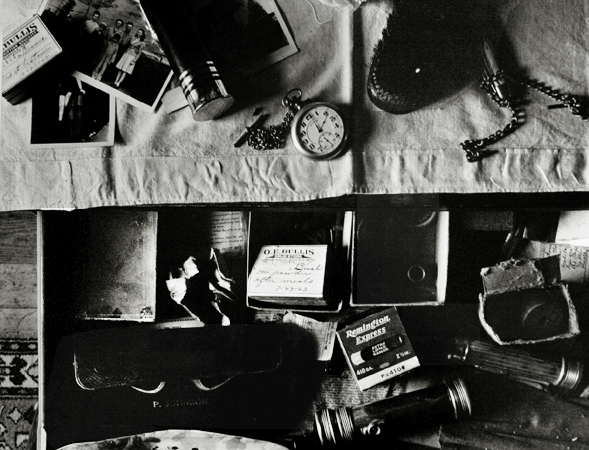Recommended reading: Wright Morris
I once had the opportunity to attend a walk-through of an exhibition of Patti Smith’s photographs at the Wadsworth Atheneum, with the artist herself in the lead. She talked about a lot of things outside of the pictures, at one point mentioning Whitman’s lists. As the smallish group moved from one gallery to another, I found myself in proximity to Smith, and I ventured: “The photographer Wright Morris said that Whitman had the photographer’s eye, but no camera.” She pondered this a moment, and said, “I like that very much.”
For half a second, I thought maybe I’d impressed the Godmother of Punk enough that she’d want me to be her new best friend. Alas, she pretty quickly turned her attention back to the group and the show. But Wright Morris had come in handy, as I found he often does for me when thinking about pictures, and – more importantly – about making pictures.
I first picked up Time Pieces, a book of Morris’s essays, when I was newish to serious photography and buying a bunch of the critical/theory books in the Aperture series, just because that seemed the serious thing to do. I didn’t know much of Morris: only a few of his pictures and none of his fiction. I know the photographs better now, but not the fiction, unfortunately. In any case, I recommend Morris solely on the strength of the essays.
The prose is clear, precise, and unfussy. Even better, it’s incisive. Almost aphoristic. To wit: “We sense that it lies within the province of photography to make both a personal and an impersonal statement. Atget is impersonal.”
To me, this is almost Zen-like in its simplicity as a statement and complexity as a thought. With the reference to Atget, we know exactly what Morris means. Which makes it helpful, but not entirely necessary for him to go on: “What we sense to be wondrous, on occasion awesome, as if in the presence of the supernatural, is the impression we have of seeing what we have turned our backs on. As much as we crave the personal, and insist upon it, it is the impersonal that moves us. It is the camera that glimpses life as the Creator might have seen it.”
Admirably, Morris pushes these ideas to make them useful as a means of making judgments: “Where distinctions can be made between images and photographs we should make them. Those that combine the impersonality of the camera eye with the invisible presence of the camera holder will mingle the best of irreconcilable elements.”
This idea of impersonality means just about everything to a certain kind of photographer, and very little to other folks. Wherever your allegiances lie, Morris has much to offer anyone who loves the camera, and the gifts it confers: “Of those who find more than they seek, the photographer is preeminent.”
Morris’s experience and expertise as a writer of fiction is brought to bear on the role of memory in making art: “When we say, ‘How well I remember!’ invariably we remember poorly. It is the emotion that is strong, not the details. The elusive details are incidental, since the emotion is what matters. In this deficiency of memory do we have the origins of the imagination? To repossess we must imagine: our first memories are as dim as they are lasting. Until recorded history, memory constituted history and memory processed by emotion was our only means of repossession. When this is done with talent, we define it as art.”
Indeed, if memory were perfect, there’d be no art: “If we remembered both vibrantly and accurately – a documentary image rather than an impression – the imaginative faculty would be blocked, lacking the stimulus necessary to fill in what is empty or create what is missing. The faculty of artful lying is image making, and not always confined to fiction writers. Precisely where memory is frail and emotion is strong, imagination takes fire.”
Expanding on this, Morris immensely pleased the late bloomer in me with his observation that “In the craft of image making there is much to be said for the slow grower.” Just a few paragraphs earlier: “The impressions of childhood, indelibly imprinted on a mind open and eager for sensations before it is cunningly attuned to ego satisfactions and evasions, are the ideal circumstances for the nature destined to be an image maker.”
Well, okay, great. And still great when he says that this “less culture-shaped child, accumulating experience before he does art” is characteristic of the American experience, “from Twain through Faulkner.” But then: “Those favored by a more cultivated background (like Henry James and Edith Wharton) are felt to be less American. This is a narrow but telling distinction.”
I get the distinction, with the same ringing clarity provided by the invocation of Atget I mentioned earlier, but . . . ouch. I love those two writers so much, and even consider their craft when thinking about pictures, but I can see the point that maybe it’s better to experience the world first and then art a little later. And here I was in my 30s and 40s envying all the kids who got to grow up in Manhattan.
Anyway, my point is not to agree or argue with Morris on this point, but rather to commend his ability to provoke thought by making concrete statements with concrete examples. At the risk of arguing against writing about photographs, which is something I like to do, I quote Morris at length:
“The artwork no longer speaks for itself. It is ironic to think, as the words flow, that the photograph was once thought to speak a more concrete, less abstract language. The slogan was that it was better than a thousand words. Thousands upon thousands of words now encumber a quantity of photographs. This flowering of writing about photography, much of it readable, informative, and innovative, is the latest example of the current cultural mania to transform one thing into another, and eventually into words. To reside in one thing or another appears to be impossible. On the evidence, the thing itself – the person, the object, the painting, the book, the music, the sunset, the operation – exists primarily as a point of departure, a launching pad from which we take off into an orbit of our own . . . Photographs, photographs of all things, were once believed to offer a point of resolution.”
And finally, one of my favorite passages, as a guy who doesn’t connect with Game of Thrones or Harry Potter (not saying they’re bad, don’t send me any hate mail, please) but prefers the real world (of Henry James and Edith Wharton, ironically): “The mind is often at play, like the summer night buzzing with insects, but to imagine, to make an image, to shape, assemble, and structure experience differs from the play of fancy and invention through the energy it receives from emotion. The image-making characteristic of science and fantasy fiction is largely free of this charge of feeling. The most remarkable events, inconceivable disasters, unheard-of creatures and identified flying objects pass through the mind without distressing the emotions. If the charge of feeling is present, it is no longer merely science-fantasy fiction.”
Time Pieces is sadly no longer in print, but you can find it pretty easily online, and its not expensive. I hope you do enjoy it.


